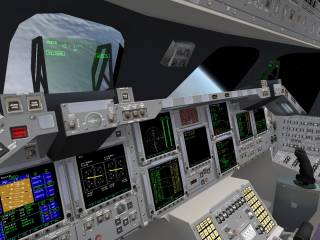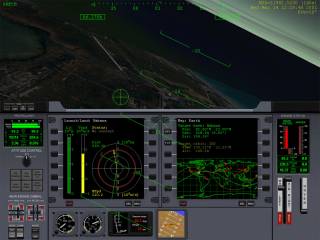Orbiter is a spaceflight simulator for the PC. It is available as a free download from the official Orbiter site. The most recent release of the game is Orbiter 2010 P1.
About
 The virtual cockpit of the Space Shuttle Atlantis.
The virtual cockpit of the Space Shuttle Atlantis.Orbiter is a Newtonian physics-based space flight simulator. It involves a lot of scientific calculations, even just to orbit the Earth. Luckily it comes with a lot of documentation and tutorials. Although the only real spacecraft available in the base install of Orbiter 2006 is the Space Shuttle Atlantis, there is a large add-on community which has produced extra spacecraft, such as the historic Apollo spacecraft.
In Orbiter, players are able to travel to various places in the Solar System. The eight planets and their respective moons are all included, and can be landed on with spacecraft. The Sun is also a celestial body which is included, and hypothetically players can land on it even though this would be impossible in real life.
 A player flies the Delta-Glider from the 2D panel perspective. The map MFD is on the right, and the VTOL MFD is on the left.
A player flies the Delta-Glider from the 2D panel perspective. The map MFD is on the right, and the VTOL MFD is on the left.A large number of instruments are available in Orbiter to help players navigate their way through the Solar System. These are presented through in-game multi-function displays (MFDs). Being realistic, it is not possible to simply point in the direction of a planet and ignite the engines to get to that planet. Instead, instruments are needed to be used by the player in order to successfully navigate to the desired target. There are thousands of stars visible in Orbiter as well, including the stars which comprise most of the constellations. If players are unfamiliar with the constellations, the simulator can also label them if with the push of a button.
 The Space Shuttle re-enters the Earth's atmosphere.
The Space Shuttle re-enters the Earth's atmosphere.Orbiter can be played from up to four perspectives. Not all space craft support all four perspectives though. All the available space craft support the most basic view which includes two Multi-function Displays (MFD's) and a HUD which provides details about altitude, heading and pitch. All space craft also support an external view, although it is impractical to play Orbiter from this perspective, as no instruments of information can be seen in this view. Some space craft in Orbiter support a 2D panel. This includes many buttons which can be clicked by the mouse which results in various functions being performed. For example, there may be a button which can be pressed to either lower or raise the landing gear. Some space craft also have a virtual cockpit view. This view shows a modeled interior to the space craft. This view looks the most realistic, but in most space craft with virtual cockpits, the buttons cannot be pressed and are thus present solely for presentation.
 The Command/Service Module from the NASSP add-on
The Command/Service Module from the NASSP add-onCasual players may find Orbiter difficult to get into due to its steep learning curve (especially if you do not read the tutorials). This learning curve is largely due to the accuracy of the physics in the game. Gravity affects almost everything the player does in Orbiter. A certain amount of thrust (or Delta-V) is required in order to accomplish things like Orbit, and even more is required if the player wishes to leave the influence of Earth's gravitational pull altogether. The atmosphere on planets is also a consideration. In the Earth's atmosphere, velocity will be lost due to friction between the air and the space craft. However, once the player leaves the atmosphere, they will be in space which is an almost perfect vacuum. This means that any thing in orbit outside of the Earth's atmosphere can remain in orbit for a long period. Additionally, Orbiter realistically models what happens when an object re-enters the Earth's atmosphere. One of the biggest faults with Orbiter is the lack of damage. This means that, although unrealistic, players can re-enter the Earth's atmosphere at high speeds, which in the real world would result in the space craft burning up. The Delta Glider IV add on includes a damage model which means players can destroy their vessel. Despite the many factors which must be considered to achieve spaceflight, Orbiter provides a rewarding experience for those willing to spend time learning some of the theories of spaceflight. The base install of Orbiter also lacks any sound, although there is a popular sound download freely available from the Orbiter website.
Orbiter 2010
On August 30, 2010, Orbiter was given a large overhaul, the largest one it had had since 2006. Still, the game remained completely simulation style, and remained accessible to older computers. After the release, the game now had many vessils that came with the game by default:
Popular add-ons
 A player controls Astronaut Eugene Cernan as he walks on the Moon during Apollo 17.
A player controls Astronaut Eugene Cernan as he walks on the Moon during Apollo 17.Although there are thousands of add-ons, some of the more popular ones include:
- NASSP - An add-on which enables the player to recreate the historic Apollo program, including Apollo 11 which was the first mission to The Moon, and Apollo 13 which was the mission in which there was a large malfunction and had to be aborted.
- AMSO - Another add-on which includes the Apollo project. This add-on is significantly easier to use by casual players of Orbiter, as many of th e difficult parts of the mission can be done by autopilots, requiring only a push of a button by the player.
- Shuttle Fleet - An add-on which includes all of NASA's past a present Space Shuttles. It enables you to fly Shuttle missions. It also includes an autopilot for the Shuttle's. Additionally, there is an expansion pack which lets players simulate many of the real missions which have been carried out by Shuttle crew.
- Delta-Glider IV (DG-IV) - A fictional space craft. It includes a huge number of features, including many useful autopilots and a realistic damage model. Many missions can be completed by the DG-IV, such as flying to the Moon and ISS. However, it's range does not enable it to fly to further planets. Because the DG-Iv is very detailed, it is probably one of the most popular add-ons.
- Orbiter Sound - The base install of Orbiter 2006 does not include sound. This add-on introduces sound, including engine sounds and a countdown.
Log in to comment